

Gambling was played by people long before the rise of Rome. The oldest known dice were found by archaeologists in northern India, where the state of Harappa once existed. These bones are made of baked clay in the III millennium BC. The Romans most likely borrowed the dice game from the Greeks, who themselves were gamblers and used the same hexagonal dice with dots on the edges, which are known to us now.
Now the world of gambling has stepped far ahead and you can gamble online, even from your phone in any corner of the world. Now gambling offers a lot more than before, visit woo casino bonuses and check for yourself.
Dice and Other Gambling Games in Ancient Rome
The Romans made dice from dried, cleaned, and ground sheep bones. The different combinations that fell out even had their names, the best “Venus”, and the worst — “dogs”. A special cup for dice, in which they were mixed for throwing, was called a “Turricula” (turret). The most well-known variant of the game is in which each player throws three dice, and the win is equal to the difference in the number of points dropped.
The Romans also played the simplest games, such as “micatio”. Two players simultaneously show several fingers on one hand, it is necessary to guess the total number of fingers shown by both players. They also played “heads or tails”, i.e. “capita aut nativism” — head or ship. On one side of the small Roman coin there was an image of the rostrum, the ship’s nose, and on the second the head of the god Janus. Another simple game is “par impair” (even or odd) when the presenter holds several pebbles in his fist, and the player must guess whether the number of these pebbles is even.
The Simplest of Roman Board Games
The simplest of the Roman board games was called “mill wheel”. The playing field was an image of a wheel with 8 spokes, each player had three chips, to win they had to be placed three in a row, as in our “tic-tac-toe”. The ancient Romans had more advanced games. One of the most common board games of the ancient Romans was called Duodecim. A camping game set made of a folding leather field with chips and dice attached to it, belonging to a Roman soldier from the XX Legion, was found in Britain, and in Roman cities, archaeologists find many “stationary” playing fields engraved on stone tabletops.
Officially, this game was banned as too gambling and ruinous for Roman citizens. The Romans found an ingenious way out — instead of a tablet of square playing fields, they simply wrote two columns of three words of six letters, each letter at the same time becoming a playing field. For example, on the tavern table, such a game sign is disguised as a menu:
- ABEMUS * INCENA
- PULLUM * PISCEM
- PERNAM * PAONEM
Translated: “We have for dinner: chicken, fish, ham, peacock”, at the bottom the inscription Bena Tores – “Bon appetit”. Moreover, the word HABEMUS (“we have”) is deliberately misspelled to fit a six-letter format.
What Was the Game?
First, the players placed 12 chips on the fields of the middle row. Then the dice were thrown, and the player who threw the highest number began to move his chips counterclockwise across the fields until they went to the opposite half and left the board. Subsequently, the game was simplified, losing the middle row. The playing field has become just a board, lined into two rows of 12 squares. Initially, all the chips of each player were lined up in a “tower” on the first square on his side of the field. It was not very convenient, because the column of chips easily fell apart from the slightest concussion.






